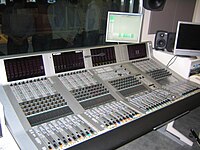Studer
This article has multiple issues. Please help or discuss these issues on the talk page. (Learn how and when to remove these template messages)
|
| Founded | 1948 in Zürich, Switzerland |
|---|---|
| Founder | Willi Studer |
| Website | studer |



Studer is a designer and manufacturer of audio equipment for recording studios and broadcasters. The company was founded in Zürich, Switzerland, in 1948 by Willi Studer. It initially became known in the 1950s for its professional tape recorders. In the 1990s the company moved into the manufacture of mixing consoles.
Management, sales, engineering, R&D and customer service were based in Regensdorf, Switzerland, until owners Harman International Industries closed down the Swiss entity in March 2018 transferring the now decentralised operation to China, Hungary, and the US. Manufacturing, marketing, and customer support were part of the Soundcraft facility in Potters Bar, England until Harman closed the Potters Bar facility in June 2016 and moved manufacturing and customer support to Hungary. Studer was a subsidiary of Harman International Industries.On February 9, 2021, Evertz Technologies Limited acquired the Studer audio brand from Harman.[1]
History[]
Willi Studer began to make high-tension oscilloscopes in 1948. These products were in production until 1968. In March 1951, Studer introduced the Revox brand name subsidiary.
In 1990, Studer sold the Studer-Revox group to Motor-Columbus AG, including all subsidiary companies. In 1991, Motor-Columbus split the Studer-Revox Group into separate Studer, Revox and manufacturing-divisions. Motor-Columbus sold several subsidiaries and plants.
The extensive reorganization culminated in the sale of the Studer group to Harman International Industries in March 1994. The Revox group was excluded and sold to private investors. On March 17, 1994, Harman completed its acquisition and acquired from Motor-Columbus AG 100% of Studer-Revox AG.
Harman paid 100 Swiss Francs (approximately US $70.00) for all of the issued and outstanding stock in Studer-Revox. Harman assumed post-acquisition indebtedness of Studer-Revox of approximately 23 million Swiss Francs (approximately US $16 million). Harman later moved some of its Studer business operations to England and merged them with operations of its Soundcraft subsidiary.
Willi Studer died on March 1, 1996.
Tape recorders[]
In 1949, Studer branched out into the audio business by modifying imported tape recorders from the United States. By 1950, they had developed their own line of tape recorders, named the Dynavox series. The company has built a variety of 2-track recorder models throughout its history for stereo recording.
Several Studer components were sold under the Revox name, with slight modifications, at a lower price. The Revox variants were designed for consumer use, with features such as IR remote control, and the omission of balanced input/output sockets. The core circuitry of the two was otherwise substantially identical. One of the company's models was the Revox A77 recorder, which was introduced in 1967.
Studer designed and produced multitrack recorders. Studer’s first multi-track machine, the model J37, was released in 1964. It recorded 4 tracks on one inch tape. A pair of J37s were used by The Beatles to record Sgt. Pepper's Lonely Hearts Club Band in 1967.[2] Later analog Studer machines were built in 8, 16, and 24-track configurations using tape widths of up to two inches.
A Studer A800 MKIII is the focus of the opening shot of the video for the 1988 Guns N' Roses song "Patience".
Sales of analog machines continued into the early 1990s, when they began to be replaced by digital recorders. In this period, Studer introduced the D820 and D827 multitrack models, which employed the Digital Audio Stationary Head standard. However, digital tape formats eventually fell out of favor with the introduction of computerized hard disk drive recording systems and software products such as Pro Tools.
Mixing consoles[]
In the mid 1990s Studer started to develop digital mixing consoles. After introduction of OnAir 2000 with Touch'n Action user interface in 1997, the D950 was the first digital large frame desk Studer introduced in 1998. With Vista Series (Vista 1, 5, 6, 7, 8, 9, V, and X) Studer launched in 2003 the Vistonics user interface with knobs-on-glass technology. Some older Vista models have been discontinued but Vista 1, 5, V, and X remain in production. Vista 5BE (Black Edition) is the latest model of this series continuing the use of x86 CPU technology replacing SHARC based DSP engines.
The Studer Vista 9M2 (launched September 2013) is a TV broadcast/live production console equipped with the patented Vistonics knobs-on-glass user interface and FaderGlow is used by TV broadcasters including the BBC, RAI, France TV, TV Globo, ABC, NRK, DR and many others. Studer also offers radio broadcast consoles with the Glacier control surfaces (replacing the now discontinued On Air 3000 and 2500 controllers) added to the remaining On Air range that includes the OnAir 1500.

Studer A80, 24-track recorder

Studer A80 at Mountain Studios used by the rock band Queen

Remote controller for Studer A800 MKIII (center left)

Studer B67, 2-track recorder

Studer A820, 2-track recorder

Studer A80, 2-track recorder, mastering version

Studer broadcasting audio console at IBA Radio Kol Israel in Jerusalem
References[]
- ^ "Evertz Announces Closing of Previously Announced Acquisition of Studer's Strategic Assets" (PDF). evertz.com.
- ^ "Behind the J37 Tape". Waves.com. Retrieved 2018-12-16.
External links[]
| Wikimedia Commons has media related to Studer. |
- Manufacturers of professional audio equipment
- Electronics companies established in 1948
- Audio equipment manufacturers of Switzerland
- Manufacturing companies based in Zürich
- Harman International
- Regensdorf
- Audio mixing console manufacturers
- 1994 mergers and acquisitions
- Swiss brands
- Swiss companies established in 1948
- Swiss companies disestablished in 1994







